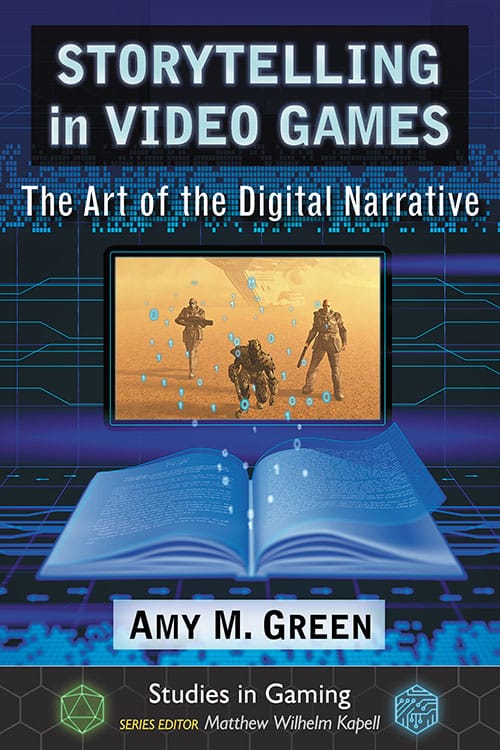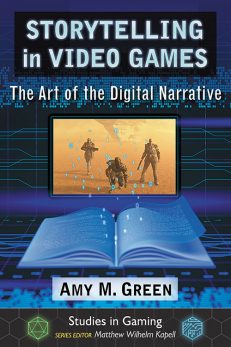Preface 1
1. Digital Storytelling and the Importance of Play 5
2. Structural Features of Digital Stories: Agency, Immersion and World Building 35
3. The Primacy of Story Part 1: Long-Form Storytelling in Digital Narratives 65
4. The Primacy of Story Part 2: Shorter Playtimes, Profound Storytelling 135
5. Video Game Study and the Higher Education Classroom 192
Chapter Notes 201
Works Cited 217
Index 225
 Review Fix chats with Storytelling in Video Games: The Art of the Digital Narrative author Dr. Amy M. Green to find out what inspired the book and why the stories in video games matter.
Review Fix chats with Storytelling in Video Games: The Art of the Digital Narrative author Dr. Amy M. Green to find out what inspired the book and why the stories in video games matter.
Review Fix: What inspired the creation of this book?
Amy M. Green: This was an idea I had for a while. I had been publishing work critically analyzing narrative in video games, but I also tended to find that some existing scholarship about video games was failing to present a fuller picture of what is possible within the field of video game study. That has changed a lot even since I published my book, but at that time, there was not as much out there that considered storytelling in video games by looking at theme, symbolism, historical and cultural contexts, and the like. Of special concern to me was that a lot of books about video games did not seem to be written by people who played and loved video games. As a result, these books often had gaps –or inaccuracies – that I felt contributed to misunderstandings about video game study.
Review Fix: What makes the video game industry worthy of a book like this in your opinion?
Green: My approach to video game study lies in the narratological study of games, meaning that I look at the stories video games tell in much the same way that I would be doing traditional literary analysis. I come from a background in literary study – my doctoral degree is in English – and my belief is that the study and understanding of storytelling is of critical importance more generally. We are a storytelling species – even our primitive and ancient ancestors sought to contextualize their understanding of the world through cave paintings, a type of storytelling. From there, we began to tell oral stories, then eventually, many cultures began to record their stories in writing.
Now, we have storytelling across many formats – written, oral, film, television, and, of course, video games. Granted, not all video games tell stories and that is fine – but the ones that do merit careful consideration. They are cultural artifacts – they reflect on history, culture, and society in important ways.
Review Fix: What was the writing process like?
Green: I think that everyone has a different writing process and approach to a project like this. I began by considering what my goals were for the book overall. I wanted to create, in some ways, a “nuts and bolts” guide to the study of storytelling in video games aimed at someone interested in video game study, but without a lot of knowledge of the field. To that end, I wanted to cover both long form games, those with a play time of 40 or more hours as I defined them in the book, and shorter ones, as length impacts both the scope of a story and how it might unfold. I also considered very short games, like the independent title Fingerbones. That game almost functions as an iteration of microfiction, while still providing a stunning sense of narrative told primarily through the environment and with an economy of specific details.
From that overall structure, I began to collate together the video game examples I wanted to include in the book. I did not want to just talk about how to study storytelling in video games – I wanted to present a number of diverse examples in each section of the book to show a practical application of how that might be done.
Review Fix: How was it different from your other books?
Green: I’ve written two other books on specific video game titles – Posttraumatic Stress Disorder, Trauma, and History in Metal Gear Solid V and A Cure for Toxic Masculinity: Male Bonding and Friendship in Final Fantasy XV in addition to a number of scholarly articles. Those all share in common a focus on one particular video game title. This is part of my training in literary study – the focus on one work, covered with depth.
Storytelling in Video Games: The Art of the Digital Narrative is different in that it focuses on a larger number of games, each illustrating a particular point about the narrative analysis of video games. This book also has a pedagogical component to it, which is not something about which I typically write. The final chapter of the book considers my own incorporation of video game study into the literature classes I teach at the University of Nevada, Las Vegas, where I am an Assistant Professor-in-Residence. My hope is that this chapter will inspire other educators to consider using video game study in their own classrooms and presents my experiences regarding how this can be done logistically.
Review Fix: How does storytelling in games differ than films and books?
Green: The primary difference has to do with video games being an immersive form of storytelling, in ways that films and books are not. The player has agency, even in a game not driven at all or almost at all by choice, to explore and observe the fictional space carefully. Additionally, the storytelling unfolds a bit differently. Films present a story focused through the eye of the camera lens, which in turn is the eye of the director. The information given through that eye – through that lens – reflects what the director wants the viewer to see. With books, the author controls the details that are presented to the reader. In a game, the player is often free to look at relatively minor details – for example, exploring the entirety of a street – rather than being limited to what is shown through the lens or written about on the page.
Video games also frequently rely on environmental storytelling and artifacts like journals, books, and letters found at various locations to help convey plot points and to further develop the fictional world. This requires the player to place close attention to details and consider their implication. The player has to want to engage with the story. There are many examples I could point to in this regard, but a compelling moment from Silent Hill 2 comes to mind. When the player explores Neely’s Bar, that person sees the message “There was a hole here. It’s gone now” written in what looks to be blood on the newspaper covering one of the windows. The message is presented without explanation or context and leads the player to consider the numerous, and all rather ominous, possibilities and questions it raises.
Review Fix: How do you feel the best game stories will be looked at in a few decades?
Green: They will be remembered in the same way in which we remember, and continue to revisit, outstanding examples of storytelling in other formats, like film, television, and literature. Stories that remain relevant do so on two levels. They provide us with insight into the historical and culture contexts out of which they were created and comment in profound ways upon our own current context.
Review Fix: What did you learn through the writing process that you weren’t expecting?
Green: I have been writing and publishing for many years, so I don’t think I would say that I learned anything new about my own process. What I did learn was the need to connect ideas across the entirety of a book, reiterating and sometimes repeating them, to remind the reader of what had been covered and how new points connected to previous ones.
Review Fix: What are your goals for the book?
Green: To underscore that video games are a relevant, and important, source of storytelling.
Review Fix: How would you like it to be remembered?
Green: This, for me, combines with the previous question. I certainly hope that gamers will enjoy the book. However, it would also mean a lot to me, as a scholar working in video game study, to have those who have not considered video games to be a relevant storytelling medium change their minds.
Review Fix: What’s next?
Green: I’ve been working quite a bit with Final Fantasy XV as of late, and just published a book considering its depiction of male friendship. My immediate focus is an article considering Kingsglaive, the film which functions as another narrative component of Final Fantasy XV’s world, as a commentary on WWII. After that, I have some other ideas I am starting to put together looking at other video games.
Review Fix: Anything else you’d like to add?
Green: No, but I appreciate the opportunity to talk about my work and my lifelong love of video games.






